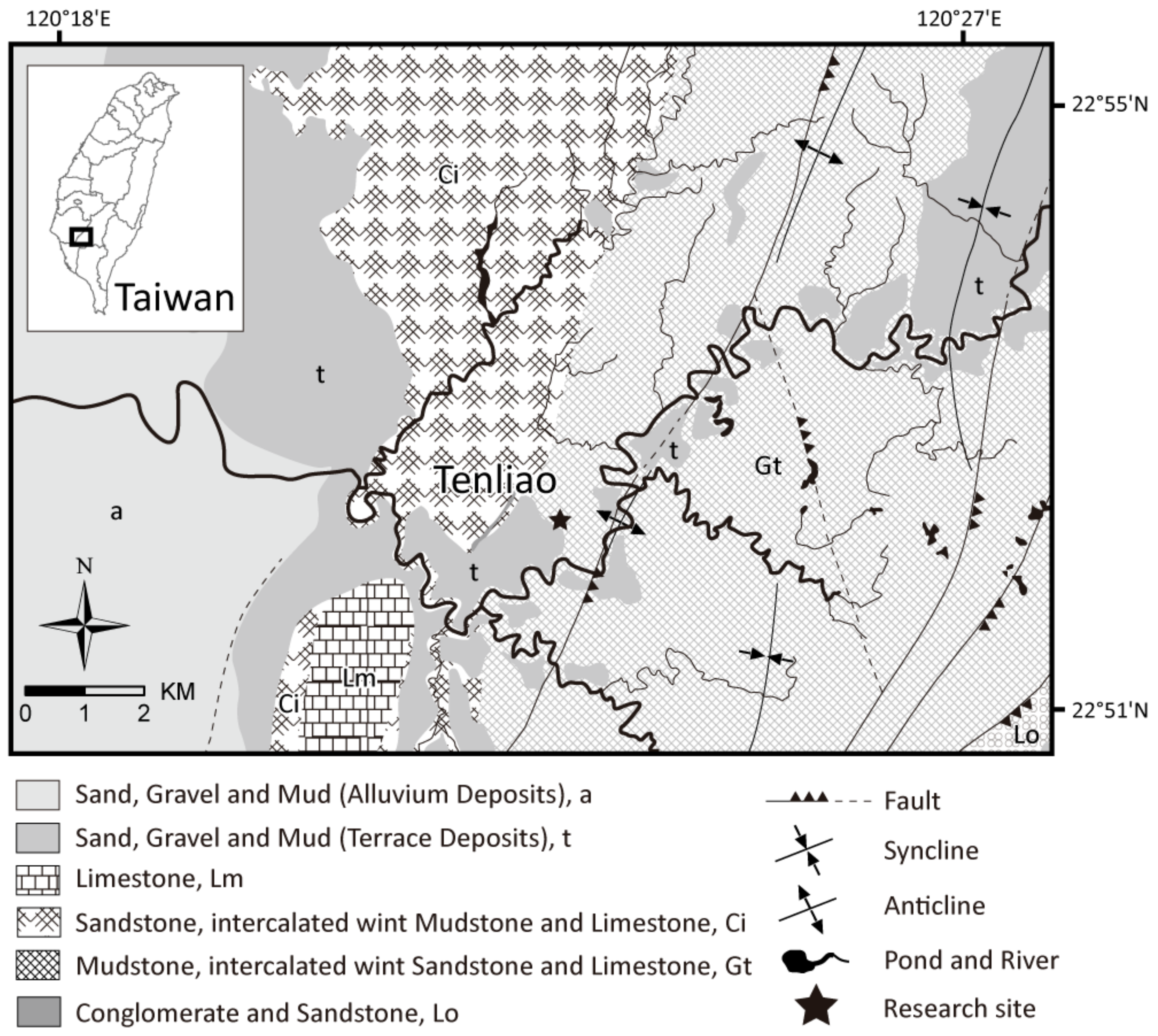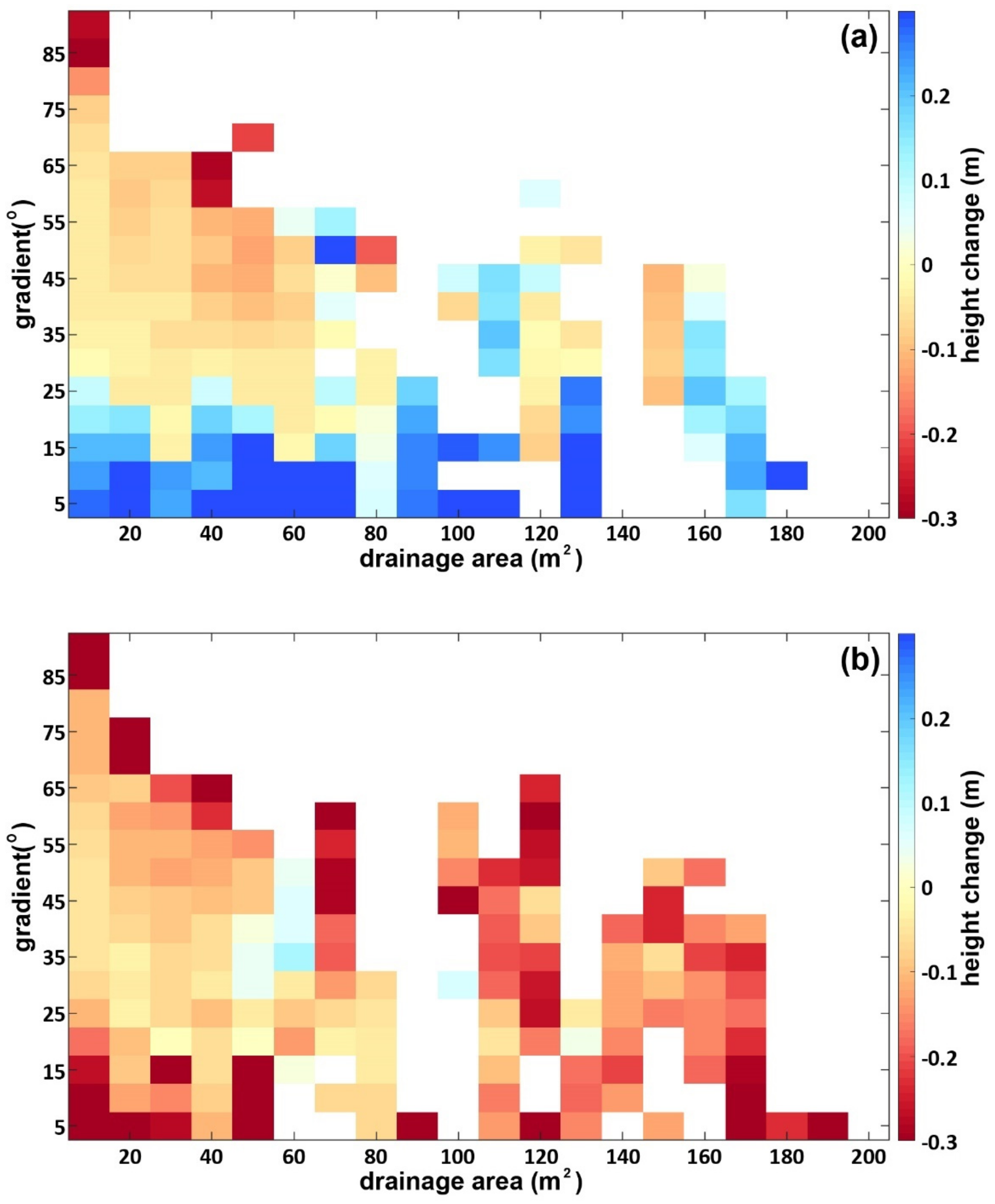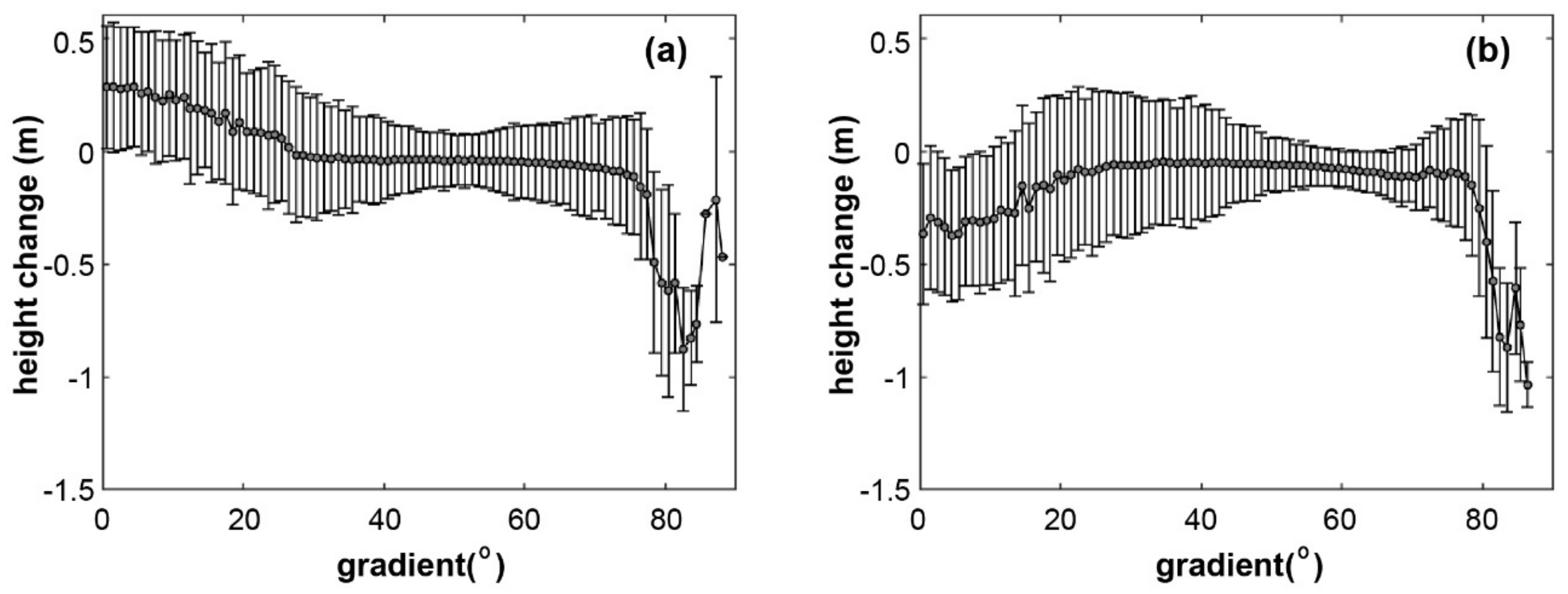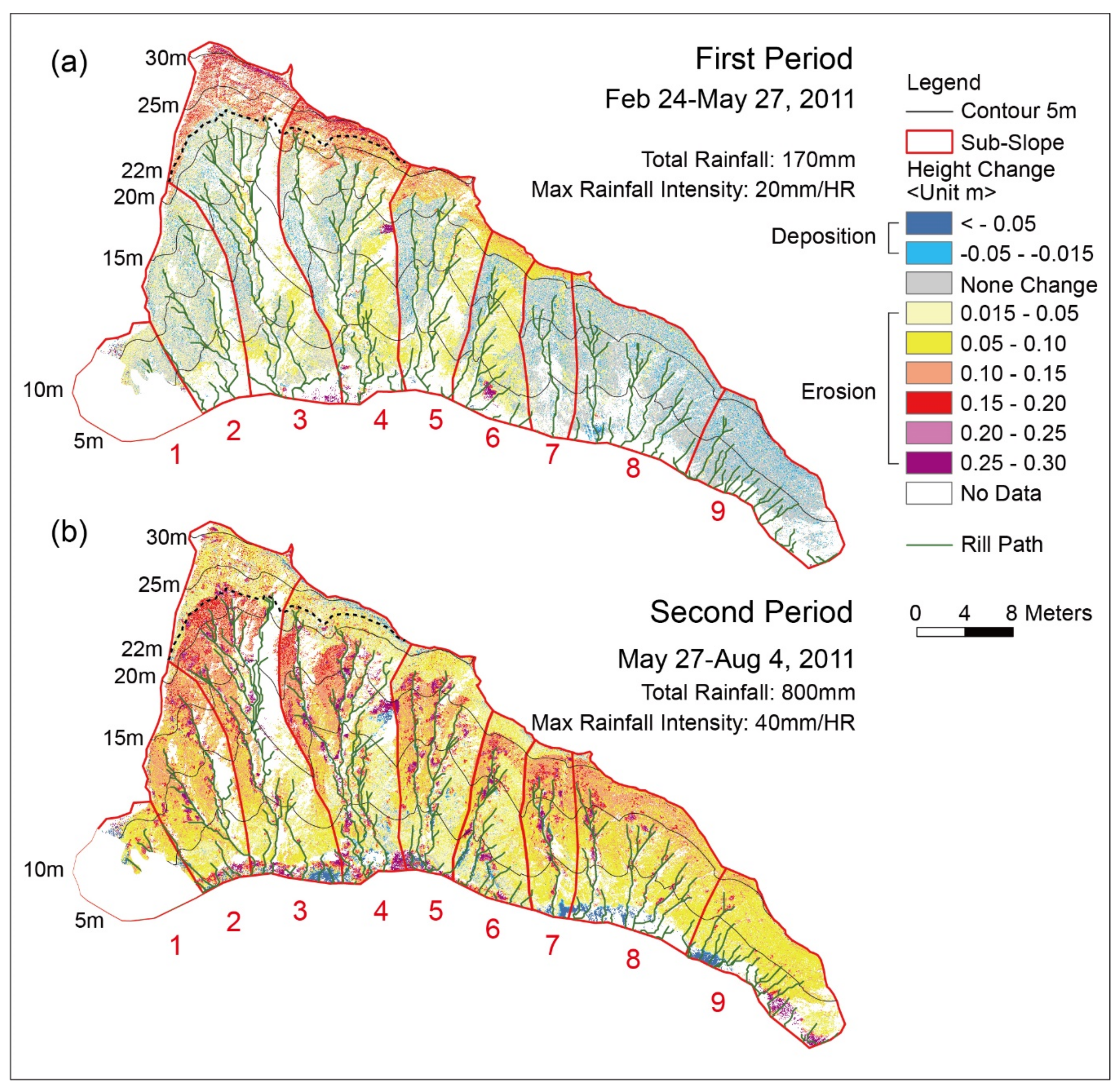Application for Terrestrial LiDAR on Mudstone Erosion Caused by Typhoons
Abstract
1. Introduction
- provide a series of quantitative surface changes after typhoon events,
- linkage erosion pattern, rainfall intensity, and hillslope gradient cause by typhoon events. We use TLS to scan a 1007 m2 hillslope. Based on the TLS results, we focused on the erosion rate and erosion pattern affected by precipitation.
2. Material and Methods
2.1. Location
2.2. Climate
2.3. TLS for Data Acquisition
2.4. DEM Processing
2.5. DEM Data Analyzing
2.6. Rainfall
3. Results
3.1. Erosion Classification
3.2. Erosion Volume According to the Different Gradients
3.3. Erosion Pattern
4. Discussion
4.1. Influence of Rainfall Intensity
4.2. Importance of Slope Gradient
4.3. Applications of High-Resolution Topography in Slope Erosion
5. Conclusions
Author Contributions
Funding
Acknowledgments
Conflicts of Interest
References
- Gautam, T.P.; Shakoor, A. Slaking behavior of clay-bearing rocks during a one-year exposure to natural climatic conditions. Eng. Geol. 2013, 166, 17–25. [Google Scholar] [CrossRef]
- Gautam, T.P.; Shakoor, A. Comparing the Slaking of Clay-Bearing Rocks Under Laboratory Conditions to Slaking Under Natural Climatic Conditions. Rock Mech. Rock Eng. 2016, 49, 19–31. [Google Scholar] [CrossRef]
- Dadson, S.J.; Hovius, N.; Chen, H.G.; Dade, W.B.; Hsieh, M.L.; Willett, S.D.; Hu, J.C.; Horng, M.J.; Chen, M.C.; Stark, C.P.; et al. Links between erosion, runoff variability and seismicity in the Taiwan orogen. Nature 2003, 426, 648–651. [Google Scholar] [CrossRef] [PubMed]
- Chen, C.T.A.; Ae, C.; Liu, J.; Tsuang, B.J. Island-based catchment—The Taiwan example. Reg. Environ. Chang. 2004, 4, 39–48. [Google Scholar] [CrossRef][Green Version]
- Baets, S.D.; Torri, D.; Poesen, J.; Salvador, M.P.; Meersmans, J. Modelling increased soil cohesion due to roots with EUROSEM. Earth Surf. Process. Landf. 2008, 33, 1948–1963. [Google Scholar] [CrossRef]
- Zhang, C.L.; Wieczorek, K.; Xie, M.L. Swelling experiments on mudstones. J. Rock Mech. Geotech. Eng. 2010, 2, 44–51. [Google Scholar] [CrossRef]
- Zhang, D.; Chen, A.; Xiong, D.; Liu, G. Effect of moisture and temperature conditions on the decay rate of a purple mudstone in southwestern China. Geomorphology 2013, 182, 125–132. [Google Scholar] [CrossRef]
- Kikumoto, M.; Putra, A.D.; Fukuda, T. Slaking and deformation behaviour. Geotechnique 2016, 66, 771–785. [Google Scholar] [CrossRef]
- Sharma, K.; Kiyota, T.; Kyokawa, H. Effect of slaking on direct shear behaviour of crushed mudstones. Soils Found. 2017, 57, 288–300. [Google Scholar] [CrossRef]
- Hu, M.; Liu, Y.X.; Ren, J.B.; Zhang, Y.; Song, L.B. Temperature-induced slaking characteristics of mudstone during dry-wet cycles. Int. J. Heat Technol. 2017, 35, 339–346. [Google Scholar] [CrossRef]
- Yamasaki, S.; Chigira, M. Weathering mechanisms and their effects on landsliding in pelitic schist. Earth Surf. Process. Landf. 1993, 494, 481–494. [Google Scholar] [CrossRef]
- Sass, O. Rock moisture measurements: Techniques, results, and implications for weathering. Earth Surf. Process. Landf. 2005, 30, 359–374. [Google Scholar] [CrossRef]
- Battaglia, S.; Leoni, L.; Rapetti, F.; Spagnolo, M. Dynamic evolution of badlands in the Roglio basin (Tuscany, Italy). Catena 2011, 86, 14–23. [Google Scholar] [CrossRef]
- Bouchnak, H.; Felfoul, M.S.; Boussema, M.R.; Snane, M.H. Slope and rainfall effects on the volume of sediment yield by gully erosion in the Souar lithologic formation (Tunisia). Catena 2009, 78, 170–177. [Google Scholar] [CrossRef]
- Hattanji, T.; Moriwaki, H. Morphometric analysis of relic landslides using detailed landslide distribution maps: Implications for forecasting travel distance of future landslides. Geomorphology 2009, 103, 447–454. [Google Scholar] [CrossRef]
- Ghimire, S.K.; Higaki, D.; Bhattarai, T.P. Gully erosion in the Siwalik Hills, Nepal: Estimation of sediment production from active ephemeral gullies. Earth Surf. Process. Landf. 2006, 31, 155–165. [Google Scholar] [CrossRef]
- Owen, J.J.; Amundson, R.; Dietrich, W.E.; Nishiizumi, K.; Sutter, B.; Chong, G. The sensitivity of hillslope bedrock erosion to precipitation. Earth Surf. Process. Landf. 2011, 36, 117–135. [Google Scholar] [CrossRef]
- Berger, C.; Schulze, M.; Rieke-Zapp, D.; Schlunegger, F. Rill development and soil erosion: A laboratory study of slope and rainfall intensity. Earth Surf. Process. Landf. 2010, 35, 1456–1467. [Google Scholar] [CrossRef]
- Chaplot, V. Impact of terrain attributes, parent material and soil types on gully erosion. Geomorphology 2013, 186, 1–11. [Google Scholar] [CrossRef]
- Chaplot, V.; Bissonnais, Y.L.E.; Sol, S.; Recherche, C.D. Field measurements of interrill erosion under different slopes and plot sizes. Earth Surf. Process. Landf. 2000, 153, 145–153. [Google Scholar] [CrossRef]
- Ribolzi, O.; Patin, J.; Bresson, L.M.; Latsachack, K.O.; Mouche, E.; Sengtaheuanghoung, O.; Silvera, N.; Thiebaux, J.P.; Valentin, C. Impact of slope gradient on soil surface features and infiltration on steep slopes in northern Laos. Geomorphology 2011, 127, 53–63. [Google Scholar] [CrossRef]
- Bou Kheir, R.; Chorowicz, J.; Abdallah, C.; Dhont, D. Soil and bedrock distribution estimated from gully form and frequency: A GIS-based decision-tree model for Lebanon. Geomorphology 2008, 93, 482–492. [Google Scholar] [CrossRef]
- Descroix, L.; González Barrios, J.L.; Viramontes, D.; Poulenard, J.; Anaya, E.; Esteves, M.; Estrada, J. Gully and sheet erosion on subtropical mountain slopes: Their respective roles and the scale effect. CATENA 2008, 72, 325–339. [Google Scholar] [CrossRef]
- Hancock, G.R.; Evans, K.G. Gully, channel and hillslope erosion–an assessment for a traditionally managed catchment. Earth Surf. Process. Landf. 2010, 35, 1468–1479. [Google Scholar] [CrossRef]
- Fang, H.; Sun, L.; Tang, Z. Effects of rainfall and slope on runoff, soil erosion and rill development: An experimental study using two loess soils. Hydrol. Process. 2015, 29, 2649–2658. [Google Scholar] [CrossRef]
- Tian, P.; Xu, X.Y.; Pan, C.Z.; Hsu, K.L.; Yang, T.T. Impacts of rainfall and inflow on rill formation and erosion processes on steep hillslopes. J. Hydrol. 2017, 548, 24–39. [Google Scholar] [CrossRef]
- Barbarella, M.; Fiani, M. Monitoring of large landslides by Terrestrial Laser Scanning techniques: Field data collection and processing. Eur. J. Remote Sens. 2013, 46, 126–151. [Google Scholar] [CrossRef]
- Clarke, M.L.; Rendell, H.M. Process-form relationships in Southern Italian badlands: Erosion rates and implications for landform evolution. Earth Surf. Process. Landf. 2006, 31, 15–29. [Google Scholar] [CrossRef]
- Della Seta, M.; Del Monte, M.; Fredi, P.; Lupia Palmieri, E. Space–time variability of denudation rates at the catchment and hillslope scales on the Tyrrhenian side of Central Italy. Geomorphology 2009, 107, 161–177. [Google Scholar] [CrossRef]
- Fang, N.F.; Zeng, Y.; Ni, L.S.; Shi, Z.H. Estimation of sediment trapping behind check dams using high-density electrical resistivity tomography. J. Hydrol. 2019, 568, 1007–1016. [Google Scholar] [CrossRef]
- Gillin, C.P.; Bailey, S.W.; McGuire, K.J.; Prisley, S.P. Evaluation of Lidar-derived DEMs through Terrain Analysis and Field Comparison. Photogramm. Eng. Remote Sens. 2015, 81, 387–396. [Google Scholar] [CrossRef]
- Teza, G.; Galgaro, A.; Zaltron, N.; Genevois, R. Terrestrial laser scanner to detect landslide displacement fields: A new approach. Int. J. Remote Sens. 2007, 28, 3425–3446. [Google Scholar] [CrossRef]
- Teza, G.; Pesci, A.; Genevois, R.; Galgaro, A. Characterization of landslide ground surface kinematics from terrestrial laser scanning and strain field computation. Geomorphology 2008, 97, 424–437. [Google Scholar] [CrossRef]
- Baldo, M.; Bicocchi, C.; Chiocchini, U.; Giordan, D.; Lollino, G. LIDAR monitoring of mass wasting processes: The Radicofani landslide, Province of Siena, Central Italy. Geomorphology 2009, 105, 193–201. [Google Scholar] [CrossRef]
- Bitelli, G.; Dubbini, M.; Zanutta, A. Terrestrial laser scanning and digital photogrammetry techniques to monitor landslide bodies. Int. Arch. Photogramm. Remote Sens. Spat. Inf. Sci. 2004, 35, 246–251. [Google Scholar]
- Abellan, A.; Vilaplana, J.M.; Martinez, J. Application of a long-range Terrestrial Laser Scanner to a detailed rockfall study at Vall de Nuria (Eastern Pyrenees, Spain). Eng. Geol. 2006, 88, 13. [Google Scholar] [CrossRef]
- Abellán, A.; Calvet, J.; Vilaplana, J.M.; Blanchard, J. Detection and spatial prediction of rockfalls by means of terrestrial laser scanner monitoring. Geomorphology 2010, 119, 162–171. [Google Scholar] [CrossRef]
- Abellán, A.; Oppikofer, T.; Jaboyedoff, M.; Rosser, N.J.; Lim, M.; Lato, M.J.; Ne, T. Terrestrial laser scanning of rock slope instabilities. Earth Surf. Process. Landf. 2013, 97, 80–97. [Google Scholar] [CrossRef]
- Corbi, H.; Riquelme, A.; Megias-Banos, C.; Abellan, A. 3-D Morphological Change Analysis of a Beach with Seagrass Berm Using a Terrestrial Laser Scanner. ISPRS Int. Geo. Inf. 2018, 7, 234. [Google Scholar] [CrossRef]
- Milan, D.J.; Heritage, G.L.; Hetherington, D. Application of a 3D laser scanner in the assessment of erosion and deposition volumes and channel change in a proglacial river. Earth Surf. Process. Landf. 2007, 32, 1657–1674. [Google Scholar] [CrossRef]
- Schwendel, A.C.; Fuller, I.C.; Death, R.G. Assessing DEM interpolation methods for effective representation of upland stream morphology for rapid appraisal of bed stability. River Res. Appl. 2012, 28, 567–584. [Google Scholar] [CrossRef]
- Vaaja, M.; Hyyppä, H.; Kukko, A.; Kaartinen, H.; Alho, P. Mapping Topography Changes and Elevation Accuracies Using a Mobile Laser Scanner. Remote Sens. 2011, 3, 587–600. [Google Scholar] [CrossRef]
- Usmanov, B.; Yermolaev, O.; Gafurov, A. Estimates of slope erosion intensity utilizing terrestrial laser scanning. Proc. Int. Assoc. Hydrol. Sci. 2015, 367, 59–65. [Google Scholar] [CrossRef]
- Nadal-Romero, E.; Revuelto, J.; Errea, P.; López-Moreno, J.I. The application of terrestrial laser scanner and SfM photogrammetry in measuring erosion and deposition processes in two opposite slopes in a humid badlands area (central Spanish Pyrenees). SOIL 2015, 1, 561–573. [Google Scholar] [CrossRef]
- Neugirg, F.; Kaiser, A.; Schmidt, J.; Becht, M.; Haas, F. Quantification, analysis and modeling of soil erosion on steep slopes using LiDAR and UAV photographs. Proc. Int. Assoc. Hydrol. Sci. 2014, 367, 51–58. [Google Scholar]
- Neugirg, F.; Kaiser, A.; Huber, A.; Heckmann, T.; Schindewolf, M.; Schmidt, J.; Becht, M.; Haas, F. Using terrestrial LiDAR data to analyse morphodynamics on steep unvegetated slopes driven by different geomorphic processes. CATENA 2016, 142, 269–280. [Google Scholar] [CrossRef]
- Sun, C.H.; Chang, S.C.; Kuo, C.L.; Wu, J.C.; Shao, P.H.; Oung, J.N. Origins of Taiwan’s mud volcanoes: Evidence from geochemistry. J. Asian Earth Sci. 2010, 37, 105–116. [Google Scholar] [CrossRef]
- Central Geological Survey, M. Geologic Map of Taiwan: Qishan Sheet, Scale 1:50,000; Central Geological Survey: New Taipei City, Taiwan, 2013.
- Pathier, E.; Fruneau, B.; Doin, M.P.; Liao, Y.T.; Hu, J.C.; Champenois, J. What are the tectonic structures accommodating the present-day tectonic deformation in South-Western Taiwan? A new interpretation from ALOS-1 InSAR and GPS interseismic measurements. In Proceedings of the Geodynamics and Environment in East-Asia: 7th France-Taiwan Earth Sciences Symposium, Hualien, Taiwan, 12–18 November 2014; pp. 12–15. [Google Scholar]
- Champenois, J.; Fruneau, B.; Pathier, E.; Deffontaines, D.; Lin, K.C.; Hu, J.C. Monitoring of active tectonic deformations in the Longitudinal Valley (Eastern Taiwan) using Persistent Scatterer InSAR method with ALOS PALSAR data. Earth Planet. Sci. Lett. 2012, 337, 12. [Google Scholar] [CrossRef]
- Chen, C.S.; Chen, Y.L. The Rainfall Characteristics of Taiwan. Mon. Weather Rev. 2003, 131, 1323–1341. [Google Scholar] [CrossRef]
- Leica-Geosystems, Leica ScanStation 2 Datasheet. Available online: https://w3.leica-geosystems.com/downloads123/hds/hds/ScanStation/brochures-datasheet/Leica_ScanStation%202_datasheet_en.pdf (accessed on 11 September 2019).
- Schaefer, M.; Inkpen, R. Towards a protocol for laser scanning of rock surfaces. Earth Surf. Process. Landf. 2010, 35, 147–423. [Google Scholar] [CrossRef]
- Huising, E.J.; Gomes Pereira, L.M. Errors and accuracy estimates of laser data acquired by various laser scanning systems for topographic applications. ISPRS J. Photogramm. Remote Sens. 1998, 53, 245–261. [Google Scholar] [CrossRef]
- Wheaton, J.M.; Brasington, J.; Darby, S.E.; Sear, D.A. Accounting for uncertainty in DEMs from repeat topographic surveys: Improved sediment budgets. Earth Surf. Process. Landf. 2010, 35, 136–156. [Google Scholar] [CrossRef]
- Lane, S.N.; Westaway, R.M.; Murray Hicks, D. Estimation of erosion and deposition volumes in a large, gravel-bed, braided river using synoptic remote sensing. Earth Surf. Process. Landf. 2003, 28, 249–271. [Google Scholar] [CrossRef]
- Kociuba, W.; Kubisz, W.; Zagórski, P. Use of terrestrial laser scanning (TLS) for monitoring and modelling of geomorphic processes and phenomena at a small and medium spatial scale in Polar environment (Scott River—Spitsbergen). Geomorphology 2014, 212, 84–96. [Google Scholar] [CrossRef]
- Kociuba, W. Analysis of geomorphic changes and quantification of sediment budgets of a small Arctic valley with the application of repeat TLS surveys. Z. Fur Geomorphol. Suppl. Issues 2017, 61, 105–120. [Google Scholar] [CrossRef]
- Kociuba, W. Assessment of sediment sources throughout the proglacial area of a small Arctic catchment based on high-resolution digital elevation models. Geomorphology 2017, 287, 73–89. [Google Scholar] [CrossRef]
- Williams, R. DEMs of difference. Geomorphol. Tech. 2012, 2, 1–17. [Google Scholar]
- Yair, A.; Bryan, R.B.; Lavee, H.; Schwanghart, W.; Kuhn, N.J. The resilience of a badland area to climate change in an arid environment. Catena 2013, 106, 12–21. [Google Scholar] [CrossRef]
- Römkens, M.J.M.; Helming, K.; Prasad, S.N. Soil erosion under different rainfall intensities, surface roughness, and soil water regimes. Catena 2002, 46, 103–123. [Google Scholar] [CrossRef]
- Wischmeier, W.H.; Smith, D.D. Rainfall energy and its relationship to soil loss. Eos Trans. Am. Geophys. Union 1958, 39, 285–291. [Google Scholar] [CrossRef]
- Kirkby, M.J.; Bracken, L.J. Gully processes and gully dynamics. Earth Surf. Process. Landf. 2009, 34, 1841–1851. [Google Scholar] [CrossRef]
- Le Roux, J.J.; Sumner, P.D. Factors controlling gully development: Comparing continuous and discontinuous gullies. Land Degrad. Dev. 2012, 23, 440–449. [Google Scholar] [CrossRef]
- Desir, G.; Marin, C. Role of erosion processes on the morphogenesis of a semiarid badland area. Bardenas Reales (NE Spain). Catena 2013, 106, 83–92. [Google Scholar] [CrossRef]
- Lee, D.H.; Chen, P.Y.; Wu, J.H.; Chen, H.L.; Yang, Y.E. Method of mitigating the surface erosion of a high-gradient mudstone slope in southwest Taiwan. Bull. Eng. Geol. Environ. 2013, 72, 533–545. [Google Scholar] [CrossRef]
- Liu, B.; Nearing, M.A.; Risse, L.M. Slope gradient effects on soil loss for steep slopes. Trans ASAE 1994, 37, 1835–1840. [Google Scholar] [CrossRef]
- Peter, K.D.; d’Oleire-Oltmanns, S.; Ries, J.B.; Marzolff, I.; Hssaine, A.A. Soil erosion in gully catchments affected by land-levelling measures in the Souss Basin, Morocco, analysed by rainfall simulation and UAV remote sensing data. Catena 2014, 113, 24–40. [Google Scholar] [CrossRef]
- Lin, J.C.; Petley, D.; Jen, C.H.; Koh, A.; Hsu, M.L. Slope movements in a dynamic environment—A case study of Tachia River, Central Taiwan. Quat. Int. 2006, 147, 103–112. [Google Scholar] [CrossRef]
- De Sy, V.; Schoorl, J.M.; Keesstra, S.D.; Jones, K.E.; Claessens, L. Landslide model performance in a high resolution small-scale landscape. Geomorphology 2013, 190, 73–81. [Google Scholar] [CrossRef]






| Date | Project Grid Size | Number of Points | Density of Points |
|---|---|---|---|
| 2011/02/24 | 0.01m × 0.01m | 1.80 M pt | 1787.49 pt/m2 |
| 2011/05/27 | 0.01m × 0.01m | 1.94 M pt | 1926.51 pt/m2 |
| 2011/08/04 | 0.01m × 0.01m | 2.42 M pt | 2403.18 pt/m2 |
| Scan World | Target ID | Mean Absolute Error | Error Vector | RMS by Ti-Point [m] | DEMs of Differences (DoD) [m] | ||
|---|---|---|---|---|---|---|---|
| X [m] | Y [m] | Z [m] | |||||
| 2011/02/24 | TL01 | 0.001 | −0.001 | 0.000 | 0.000 | 0.004 | First period 0.00336 |
| TL02 | 0.003 | 0.003 | 0.000 | 0.000 | |||
| TL03 | 0.002 | 0.001 | 0.001 | −0.001 | |||
| TL04 | 0.003 | 0.003 | 0.000 | 0.000 | |||
| 2011/05/27 | TL01 | 0.003 | 0.001 | 0.000 | 0.003 | 0.002 | |
| TL02 | 0.004 | −0.003 | 0.001 | −0.001 | |||
| TL03 | 0.001 | 0.000 | 0.000 | −0.001 | Second period 0.00297 | ||
| TL04 | 0.002 | 0.002 | −0.001 | −0.001 | |||
| 2011/08/04 | TL01 | 0.001 | 0.000 | 0.000 | 0.000 | 0.005 | |
| TL02 | 0.001 | −0.001 | −0.001 | 0.000 | |||
| TL07 | 0.002 | −0.002 | 0.000 | 0.000 | |||
| TL11 | 0.003 | 0.002 | −0.002 | −0.001 | |||
| TL022 | 0.001 | 0.000 | −0.001 | −0.001 | |||
| Period | Date | Total Precipitation | Duration | Highest Rainfall Intensity | Typhoon |
|---|---|---|---|---|---|
| First | 02/23~05/27 | 170mm | 51 hr | 20 mm/h | None |
| Second | 05/27~08/04 | 800 mm (222mm by Meari, 307mm by Ma-on) | 170 hr | 40 mm/h | Meari and Ma-on |
| Period | Net Erosion (m3) | Erosion Rate (m3/m2) | Net Deposition (m3) | Total Rainfall (mm) | Max Rainfall Intensity (mm/h) |
|---|---|---|---|---|---|
| Frist | −56.4495 | −0.050983 | 28.1664 | 170 | 20 |
| Second | −94.5597 | −0.07745 | 16.9932 | 800 | 40 |
© 2019 by the authors. Licensee MDPI, Basel, Switzerland. This article is an open access article distributed under the terms and conditions of the Creative Commons Attribution (CC BY) license (http://creativecommons.org/licenses/by/4.0/).
Share and Cite
Cheng, Y.-C.; Yang, C.-J.; Lin, J.-C. Application for Terrestrial LiDAR on Mudstone Erosion Caused by Typhoons. Remote Sens. 2019, 11, 2425. https://doi.org/10.3390/rs11202425
Cheng Y-C, Yang C-J, Lin J-C. Application for Terrestrial LiDAR on Mudstone Erosion Caused by Typhoons. Remote Sensing. 2019; 11(20):2425. https://doi.org/10.3390/rs11202425
Chicago/Turabian StyleCheng, Yeuan-Chang, Ci-Jian Yang, and Jiun-Chuan Lin. 2019. "Application for Terrestrial LiDAR on Mudstone Erosion Caused by Typhoons" Remote Sensing 11, no. 20: 2425. https://doi.org/10.3390/rs11202425
APA StyleCheng, Y.-C., Yang, C.-J., & Lin, J.-C. (2019). Application for Terrestrial LiDAR on Mudstone Erosion Caused by Typhoons. Remote Sensing, 11(20), 2425. https://doi.org/10.3390/rs11202425






